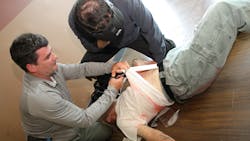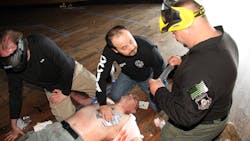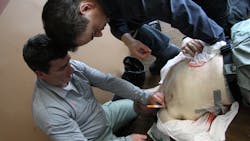The Value of Increased Medical Training for All Officers
Without a doubt, the faster you can get proper trauma care to any injured victim, the greater their chances of surviving the injury. Equally assured, the large majority of emergency calls will see a law enforcement officer on scene before members of the fire department or emergency medical system (EMS) personnel arrive. As trained first responders, officers cannot wait around for EMS to arrive but are duty-bound to start providing emergency care as quickly as possible within the confines of their training. Further, there is no segment of potential law enforcement duty that wouldn’t benefit from having a higher level of first-aid training and the carry-over into off-duty hours is of value as well.
For decades most states have required CPR and advanced first-aid certifications for new officers. Some states have required annual or semi-annual recertification—but that often goes ignored due to limited training time availability, lack of instructor availability and simple lack of concern (in some cases). In more recent years, the use of tourniquets and automatic electronic defibrillators (AEDs) has increased greatly. Even with the addition of items to be trained, the number of hours available has rarely been increased so more is being taught in the same amount of time which means less time for the officer being trained to master each knowledge item and/or physical skill.
Yes, it’s true. Using an AED is something you could probably train a monkey to do. The contemporary versions even talk to you and tell you what to do and when to do it. They give you the appropriate warnings to make sure you don’t get shocked yourself as the care provider. Using a tourniquet also requires training and we’ve seen widespread deployment of them in recent years. It seems that command staff personnel are finally catching on, and convincing those who approve budgets, that officers are at risk on the street and may need to stop life-threatening loss of blood due to injury.
But therein is the crux of the problem: budget. When the budget request is being built far more has to be considered than just dollars. Time also has to be budgeted because it converts into cost. Equipment has to be considered because it always has a cost but rarely, if ever, is the potential benefit of it—and the attached savings thanks to that benefit—taken into consideration. Why? Because it’s impossible to project, but we can examine a few of the ways the savings could be immeasurable.
Take for example a police academy class taking the training for CPR and advanced first-aid and testing day has arrived. Two members, rookies going through the academy, are currently certified emergency medical technicians (EMTs). Not only do they represent less of a burden on the instructor cadre training the course, but they also can offer assistance in training and testing if the academy staff will allow it and leverage them for that use. That option can save the agency manpower cost because it’s one or two additional instructors that don’t have to be assigned to the academy on those days. The “trickle down” effect means the agency also saves the manpower cost of having to replace those officers in their normal duty assignments. By having two EMT certified rookies in the academy class, being temporarily and specifically used to support the other instructors, the agency saves the cost of four shifts of manpower.
That’s an example of agency specific savings. What about “the bigger picture?” If more patrol officers were EMT-B (EMT basic) certified, would it save the governmental organization (a county for the sake of this article) other dollars? In high-density population areas where the local EMS system runs a lot of calls, the emergency demand is often due to criminal action so law enforcement gets dispatched as well. Nine times out of ten, the police/deputies get there first and would be available to provide emergency first-aid / trauma care with a couple of things being assumed: 1) the scene is under control and providing such care is safe for all involved; 2) the officers have the requisite training and certifications, and 3) the proper EMS equipment is available to the officers in their patrol vehicle.
Having patrol officers trained as EMTs would, in such a situation, reduce time spent on scene for all officers and EMS personnel involved. If there are two officers and two EMTs and just 15 minutes of total time is saved on scene, then one hour of manpower has been saved. In the busier jurisdiction where 50 or more emergency medical calls go out each day, the potential long term savings could be significant; as in 14,000+ man-hours per year significant.
One of the biggest arguments against getting officers certified as EMTs is the cost, both in actual paid services cost and the man-hours spent by the officers in training. The most common model for officers getting EMT certified is either to attend a course offered at a local educational institution and taking three to four months (part time) to complete, or the officers can join / attend the local volunteer firehouse training and take six months (again, part time) to complete the training. Depending on how the local government/jurisdictions handle the billing, the cost can be as little as zero dollars for training, plus about $300 for materials, up to $1,500 for the training, plus the $300 for materials. Neither of those models takes into consideration the nearly 200 hours each trainee officer will spend in class and doing course work. Even at the low rate of $20 per hour, that’s an additional $4,000 of manpower being spent.
One organization, the Commonwealth Criminal Justice Academy (CCJA) located in Fredricksburg, Virginia has come up with a solution: they offer the EMT-B course as a 17-day program (approximately eight hour days = 136 hours full time). The cost is $1,500 plus the book ($300) and includes clinical hours at the local hospital or on an ambulance (required by the state). Upon completion the trainees are eligible to test for the state and national registry EMT tests and their students’ pass rate for both of those tests is high simply because their in-house test is far more difficult. Additionally, if flexibility of schedule is required by the attending student, CCJA has an option for taking the EMT-B program online. The $2K cost grants six months of online access to the training and then the student has to visit CCJA’s headquarters to perform the written and hands on testing. For some, the flexibility is worth the extra cost and may represent the only option a student has for acquiring the training.
When asked why CCJA offers EMT-B training in both formats, Deputy Tom Perroni, the Academy Director says, “As the world evolves and changes, so has medicine in law enforcement. Police officers have always been first responders but today we take on that role in a greater way. Examples for the day are treatment of opioid overdoses and trauma care being provided at active shooter / mass casualty events. Because, as we all know, EMS isn’t coming in until the scene is safe and someone can bleed to death in three minutes or less.”
All of that makes a great argument for getting officers certified as EMTs as part of their basic academy class. We can easily see that it doesn’t require the addition of months of training, but merely the addition of roughly two and a half weeks.
Are there real world examples of how such training would save lives? Yes. In this author’s basic academy class during one range day, a student officer shot himself in the thigh as he was attempting to draw his weapon. The holster was an older design and a combination of holster malfunction and trainee action resulted in one shot being fired into the top of the student’s thigh. The round-nose projectile traveled down the leg, essentially following the line of the quadriceps and stopped just above the student’s kneecap. While there were plenty of academy and firearms instructors on site, the only certified EMT was a fellow academy student who stepped up and provided the needed emergency care until an ambulance arrived.
Another example is the anecdotal story from the shooting that occurred at Virginia Tech in 2007. One victim was reportedly shot and received a laceration to her liver. The two SWAT Medics on scene, after it was confirmed secure, provided care to that victim, keeping her alive until they could get her to the emergency room at the local hospital. That is assuredly a life threatening injury and blood loss from such could have caused death in a very short time frame if proper medical care and maintenance of such wasn’t available. Those two SWAT Medics can be credited with saving that life. It’s an example of what other officers could be doing daily if greater levels of emergency medical training were provided across the board.
Editor’s Note: Deputy Tom Perroni is a nationally registered EMT. He is a FLETC Tactical Medical Instructor and is certified by the National Association of Emergency Medical Technicians as a Tactical Combat Casualty Care and Pre-Hospital Trauma Life Support instructor. He is a street experienced SWAT Medic and is the Medic for the Spotsylvania County (VA) Urban Search and Rescue team.
About the Author
Lt. Frank Borelli (ret), Editorial Director
Editorial Director
Lt. Frank Borelli is the Editorial Director for the Officer Media Group. Frank brings 20+ years of writing and editing experience in addition to 40 years of law enforcement operations, administration and training experience to the team.
Frank has had numerous books published which are available on Amazon.com, BarnesAndNoble.com, and other major retail outlets.
If you have any comments or questions, you can contact him via email at [email protected].



